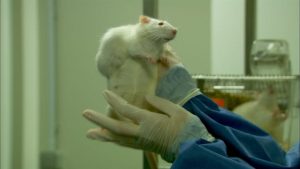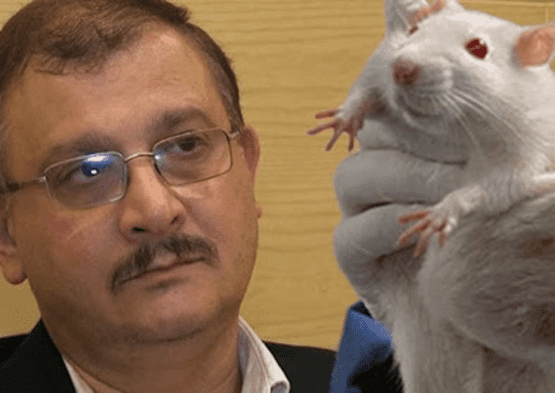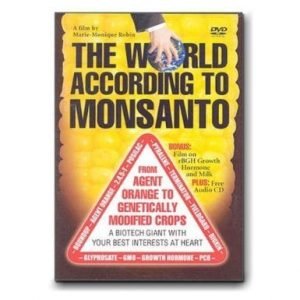(CorbettReport.com) On 19 September 2012, the journal Food and Chemical Toxicology published a peer-reviewed paper entitled “Long term toxicity of a Roundup herbicide and a Roundup-tolerant genetically modified maize.” The two-year toxicity study, which cost €3.2 million, was conducted at the University of Caen by Séralini and seven colleagues and was the first ever study to examine the long-term (lifetime) effects of eating GMOs. It confirmed that both GM food and Roundup® were toxic to mammals. The authors fed GMO corn (11% of their diet) to rats (with and without glyphosate as Roundup®) for 24 months instead of the 90 day, self-administered tests which are used by the GM industry and approved by EFSA and FDA. The rats started to develop different sorts of tumors (mammary, ovarian, pituitary, skin and renal etc.) and hepato-renal disorders beginning at 4 months (120 days), premature death of 50% male and 70% female, and severe organ damage.
The researchers followed 200 rats over two years, divided into 10 groups each of 10 males and 10 females. Three of the groups were fed Monsanto’s patented NK603 GMO corn alone, three groups were fed the corn treated with Roundup herbicide, three groups were fed Roundup-treated water but no GMO corn and a control group was fed neither GMO corn nor Roundup herbicide. The team’s results indicated that the rats fed the Roundup or the GMO corn, separately or combined, were more likely to experience a range of ill health effects than the non-GMO control group. Tellingly, the adverse health effects did not start to appear until the fourth month of the study, while a previous industry-sponsored feeding trial on the same corn variety only lasted three months. That study did find signs of toxicity as well, but these results were dismissed as “not biologically meaningful.”
The paper and its results, deemed “surprising” because it goes against all of the industry-sponsored research showing the supposed safety of GMOs, caused an immediate stir in the scientific community and online.
 But it was not long at all before the biotech industry PR machine went into damage control mode and began smearing the study.
But it was not long at all before the biotech industry PR machine went into damage control mode and began smearing the study.
The desperation became apparent when the European Food Safety Authority was tasked with examining the study that threatened to expose the shoddy approval process that the EFSA itself had used to conclude in 2009 that the NK603 maize was “as safe as conventional maize.”
As researcher and author of “Seeds of Destruction,” William Engdahl, points out in a new op-ed, “EFSA argued that Seralini had used the wrong kind of rats, not enough rats and that the statistical analysis was inadequate. By these standards, all toxicity studies on glyphosate and GMOs should be retracted because they used the same type and approximate number of rats as those in the Séralini study.”
Amazingly, despite this concerted PR campaign to smear the Seralini study, seven “expert witnesses” were unable to rebut the study in a Filipino courtroom. In October, a Flipino court of appeals upheld a decision to ban BT eggplant from the country despite the efforts of seven industry witnesses attempting to rebut the substance of Seralini’s findings.
Perhaps this is why the Journal of Food and Chemical Toxicology took the unprecedented decision to retract the study. Unprecedented because it goes against the journal’s own express principles and guidelines for such retractions. The publisher of the journal, Elsevier, is a member of the Committee on Publication Ethics, whose criteria for retracting a paper are:
- Clear evidence that the findings are unreliable due to misconduct (e.g. data fabrication) or honest error;
- Plagiarism or redundant publication;
- Unethical research.
The editor of the journal, Dr. A. Wallace Hayes, himself admits that the paper meets none of these criteria. In his own statement on the retraction, he admits that he “found no evidence of fraud or intentional misrepresentation of the data.” Yet still, the paper is being retracted because “the results presented (while not incorrect) are inconclusive,” apparently a new standard for article retraction that seems to apply especially to articles critical of the GMO industry in general and Monsanto products in particular.
It is not at all unfair to be cynical about this retraction either. On a radio program late last month, Dr. E. Ann Clark pointed out a surprising connection between the Journal and Monsanto that might account not only for the retraction of the Seralini paper, but also the recent retraction of a similar study from Brazil that demonstrated the toxic effects on mice of the Bacillus thuringiensis insecticide that forms the basis of the Bt GMO crops.
That a former Monsanto scientist should find himself in charge of a specially-created post at the very journal that published two landmark studies questioning the safety of that company’s products should surprise no one who is aware of the Monsanto revolving door. This door is responsible for literally dozens of Monsanto officials, lobbyists and consultants finding themselves in positions of authority in the government bodies that are supposedly there to regulate the company and its actions. This list of officials includes Linda Fisher, a senior EPA official who later became Monsanto’s VP of Government and Public Affairs, Michael Taylor, Obama’s Deputy FDA Commissioner who also served as Monsanto’s VP for Public Policy, and US Supreme Court Justice Clarence Thomas, who served as a corporate lawyer for Monsanto in the 1970s. These positions of influence have been used to help Monsanto and its biotech peers obtain an FDA ruling which asserts that GMO foods are not substantially different from non-modified foods, win approval for their products from regulators by self-sponsoring studies with almost identical methodologies to the Seralini study that was just retracted, and pass favorable legislation like the Monsanto Protection Act, preventing the company from being taken to federal court in the event that GMOs are discovered to be harmful to human health. In his position as “Associate Editor for Biotechnology,” former Monsanto employee Richard E. Goodman has now overseen the retraction of two papers that had been critical of his former employer, yet this fundamental conflict of interest is nowhere commented on in reportage of the Seralini study’s retraction.
 Sadly, this is par for the course when it comes to the so-called science behind the safety of GMOs. Time after time, shoddy and poorly-designed toxicity studies that show the safety of these products are given the seal of approval by bought-and-paid-for regulators, and independent studies that show contrary findings are subjected to arbitrary and nonsensical principles that supposedly undermine their validity. As a recent article at GM Watch points out, numerous GM-related studies have been retracted in the past few years for misleading and downright fraudulent research.
Sadly, this is par for the course when it comes to the so-called science behind the safety of GMOs. Time after time, shoddy and poorly-designed toxicity studies that show the safety of these products are given the seal of approval by bought-and-paid-for regulators, and independent studies that show contrary findings are subjected to arbitrary and nonsensical principles that supposedly undermine their validity. As a recent article at GM Watch points out, numerous GM-related studies have been retracted in the past few years for misleading and downright fraudulent research.
The list of frauds and abuses continue to mount, from concerns over the introduction of Bt Brinjal in India to the mysterious appearance of GMO wheat in supposedly non-GMO crops in the western United States to the appearance of unapproved GM corn in shipments of supposedly non-GMO corn to China. These types of problems have led to the outright refusal of a growing number of countries to accept genetically modified crops. But in a world where the issue of containment of GMO crops is increasingly called into question, and where even the ability to label GMO foods may be stripped from the people altogether thanks to overarching closed-door agreements like the Trans-Pacific Partnership currently under negotiation between the US and 11 of its Pacific Rim counterparts, these issues are becoming increasingly pressing. And if critical science, like that conducted by Seralini’s team, can be so easily sidelined, dismissed and retracted, what does that say about the system that is currently in place to ensure the validity and accuracy of food toxicity studies?
As a team of independent scientists and researchers from across the world wrote in an open letter during the eruption of the Seralini affair:
“When those with a vested interest attempt to sow unreasonable doubt around inconvenient results, or when governments exploit political opportunities by picking and choosing from scientific evidence, they jeopardize public confidence in scientific methods and institutions, and also put their own citizenry at risk. Safety testing, science-based regulation, and the scientific process itself, depend crucially on widespread trust in a body of scientists devoted to the public interest and professional integrity. If instead, the starting point of a scientific product assessment is an approval process rigged in favor of the applicant, backed up by systematic suppression of independent scientists working in the public interest, then there can never be an honest, rational or scientific debate.”
Original December 2013 Report from CorbettReport:
https://www.youtube.com/watch?v=ShJTcIlTna0
How Monsanto Silences Dissent (Update!) (by James Corbett, Corbett Report)
August 27, 2016
After Monsanto was successful getting the original study retracted using their manipulative tactics (the retraction heavily covered by the sell-out mainstream media), Seralini won a couple of lawsuits for libel where the research was confirmed in spite of Monsanto’s best efforts in opposition (where forgery and other fraud was proven on their behalf), and was later republished (uncovered by mainstream media).
The republished study results were:
Biochemical analyses confirmed very significant chronic kidney deficiencies, for all treatments and both sexes; 76% of the altered parameters were kidney-related. In treated males, liver congestions and necrosis were 2.5 to 5.5 times higher. Marked and severe nephropathies were also generally 1.3 to 2.3 times greater. In females, all treatment groups showed a two- to threefold increase in mortality, and deaths were earlier. This difference was also evident in three male groups fed with GM maize. All results were hormone- and sex-dependent, and the pathological profiles were comparable. Females developed large mammary tumors more frequently and before controls; the pituitary was the second most disabled organ; the sex hormonal balance was modified by consumption of GM maize and Roundup treatments. Males presented up to four times more large palpable tumors starting 600 days (significant considering lab rats live 3 years on average) earlier than in the control group, in which only one tumor was noted. These results may be explained by not only the non-linear endocrine-disrupting effects of Roundup but also by the overexpression of the EPSPS transgene or other mutational effects in the GM maize and their metabolic consequences.
https://www.youtube.com/watch?v=QxU9sgX7_-E
Additional Resources:
- GMO Food: It’s Worse than we Thought (by Dr. Russell Blaylock) – Watch Video
- Stomach Problems and GMO Food – Dr. Tent: Watch Video
- The World According to Monsanto Documentary – Watch Video
- Top 10 GMO Foods to Avoid – Watch Video
- Wikipedia: Seralini Affair
- Seeds of Death: Unveiling the Lies of GMO’s – Watch Video (covers Seralini study at 26:30 mark)
Recommended Books/DVD’s:
Monsanto’s controversial past combines some of the most toxic products ever sold with misleading reports, pressure tactics, collusion, and attempted corruption. They now race to genetically engineer (and patent) the world s food supply, which profoundly threatens our health, environment, and economy. Combining secret documents with first-hand accounts by victims, scientists, and politicians, this widely praised film exposes why Monsanto has become the world s poster child for malignant corporate influence in government and technology. A film by Marie-Monique Robin. This DVD also includes a bonus film on rbGH by Jeffrey M. Smith, and the audio CD, Don t Put That in Your Mouth.
 This skillfully researched book focuses on how a small socio-political American elite seeks to establish its control over the very basis of human survival, the provision of our daily bread. Control the food and you control the people. This is no ordinary book about the perils of GMO. Engdahl takes the reader inside the corridors of power, into the backrooms of the science labs, behind closed doors in the corporate boardrooms. The author reveals a World of profit-driven political intrigue, government corruption and coercion, where genetic manipulation and the patenting of life forms are used to gain worldwide control over food production. The book is an eye-opener, a must-read for all those committed to the causes of social justice and World peace.
This skillfully researched book focuses on how a small socio-political American elite seeks to establish its control over the very basis of human survival, the provision of our daily bread. Control the food and you control the people. This is no ordinary book about the perils of GMO. Engdahl takes the reader inside the corridors of power, into the backrooms of the science labs, behind closed doors in the corporate boardrooms. The author reveals a World of profit-driven political intrigue, government corruption and coercion, where genetic manipulation and the patenting of life forms are used to gain worldwide control over food production. The book is an eye-opener, a must-read for all those committed to the causes of social justice and World peace.
 Are GMOs really that bad? A prominent environmental journalist takes a fresh look at what they actually mean for our food system and for us.
Are GMOs really that bad? A prominent environmental journalist takes a fresh look at what they actually mean for our food system and for us.
In the past two decades, GMOs have come to dominate the American diet. Advocates hail them as the future of food, an enhanced method of crop breeding that can help feed an ever-increasing global population and adapt to a rapidly changing environment. Critics, meanwhile, call for their banishment, insisting GMOs were designed by overeager scientists and greedy corporations to bolster an industrial food system that forces us to rely on cheap, unhealthy, processed food so they can turn an easy profit. In response, health-conscious brands such as Trader Joe’s and Whole Foods have started boasting that they are “GMO-free,” and companies like Monsanto have become villains in the eyes of average consumers.
Where can we turn for the truth? Are GMOs an astounding scientific breakthrough destined to end world hunger? Or are they simply a way for giant companies to control a problematic food system?
Environmental writer McKay Jenkins traveled across the country to answer these questions and discovered that the GMO controversy is more complicated than meets the eye. He interviewed dozens of people on all sides of the debate—scientists hoping to engineer new crops that could provide nutrients to people in the developing world, Hawaiian papaya farmers who credit GMOs with saving their livelihoods, and local farmers in Maryland who are redefining what it means to be “sustainable.” The result is a comprehensive, nuanced examination of the state of our food system and a much-needed guide for consumers to help them make more informed choices about what to eat for their next meal.
 Discover the safe, effective, delicious cleanse that took Instagram by storm! This 5-day detox program allows you to eat whole, nutrient-rich foods—and feel satisfied and energized while dropping pounds!
Discover the safe, effective, delicious cleanse that took Instagram by storm! This 5-day detox program allows you to eat whole, nutrient-rich foods—and feel satisfied and energized while dropping pounds!
As a professional model, Nikki Sharp traveled constantly, barely slept, skipped meals, and relied on quick fixes to stay skinny, all of which took a toll on her physical and emotional health. Realizing she needed to make a serious change, she began to study integrative nutrition—and learned that the key to weight loss, radiant skin, and overall well-being is not starving yourself but eating. That’s right: eating! Sharp created her detox plan based on the knowledge that in the right combinations, real whole foods—grains, vegetables, fruits, and spices—can aid digestion, burn body fat, flush out toxins, reduce bloating, banish fatigue, and clear up acne.
Unlike other cleanses, The 5-Day Real Food Detox allows you to eat five times a day—and shed a pound a day—with meals and snacks developed by Sharp (and backed by a nutritionist and a registered dietician). Even better, the recipes, including Love Pancakes, Spinach & Chickpea Hummus, Black Bean Burgers, Cauliflower Mash, and Taco Bowl, have been taste-tested by Sharp’s many of 300,000-plus Instagram followers, who have done the plan and seen amazing results.
 There are 3 types of food in the United States.
There are 3 types of food in the United States.
1) Organic food,
2) Old-fashioned, conventional, non-GMO food.
3) GMO (genetically engineered) food
How do I know which food is GMO and which food is the regularly priced, old-fashioned, conventional, non-GMO food? I had played with GMO fire and every time I got burned. This book is my story about my tragic decline and my uprising efforts to heal myself.




